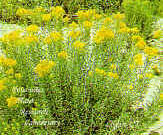 Rayless goldenrod (Haplopappus heterophyllus), rosea, or jimmy weed, is an erect, bushy, unbranched perennial shrub, growing from .75-1.5 meters tall. The leaves are alternate, linear, and sticky, and the flowers are yellow. It is toxic to horses, cattle, sheep, and goats. The presumed toxic substance, trematone, is the same toxin found in white snakeroot (Eupatorium rugosum). White snake root is a common poisonous plant in the Ohio river valley and eastern United States. Trematone is excreted in the milk of lactating animals so that the young may become poisoned by the consumption of contaminated milk (milk sickness). The toxin is present in both green and dry plant Rayless goldenrod (Haplopappus heterophyllus), rosea, or jimmy weed, is an erect, bushy, unbranched perennial shrub, growing from .75-1.5 meters tall. The leaves are alternate, linear, and sticky, and the flowers are yellow. It is toxic to horses, cattle, sheep, and goats. The presumed toxic substance, trematone, is the same toxin found in white snakeroot (Eupatorium rugosum). White snake root is a common poisonous plant in the Ohio river valley and eastern United States. Trematone is excreted in the milk of lactating animals so that the young may become poisoned by the consumption of contaminated milk (milk sickness). The toxin is present in both green and dry plant material. material.
Where and When It Grows
This shrub grows on the dry rangelands from southern Colorado into Texas, New Mexico, and Arizona. It grows especially well in river valleys and along drainage areas. Poisoning is most common in late fall and winter, particularly after
snowfall that covers other forage.
How It Affects Livestock
 Daily consumption of 1 to 1.5 percent of an animal's weight of the green plant for 1 to 3 weeks will produce signs of poisoning in horses, cattle, and sheep. Death will result if the affected animals are not removed from access to the plant early. The condition it produces in cattle is known as trembles. As the toxin is secreted in milk, nursing young may become poisoned by consuming milk. The dam may not show any signs of poisoning when grazing goldenrod. Daily consumption of 1 to 1.5 percent of an animal's weight of the green plant for 1 to 3 weeks will produce signs of poisoning in horses, cattle, and sheep. Death will result if the affected animals are not removed from access to the plant early. The condition it produces in cattle is known as trembles. As the toxin is secreted in milk, nursing young may become poisoned by consuming milk. The dam may not show any signs of poisoning when grazing goldenrod.
Signs and Lesions of Poisoning Lassitude and depression Stands in a humped-up position; stiff gait when walking Trembling of muscles of nose and legs, especially after exercise; as the condition
worsens, the whole body may shake Weakness Constipation and dribbling of urine Recumbency Acetone odor on the breath Coma Terminal respiration consists of prolonged inspiration, a short pause, and forced
expiration Death Myocardial necrosis and fibrosis of cardiac and skeletal muscles Degenerative changes of the liver How to Reduce Losses
Poisoning of livestock by rayless goldenrod can best be prevented by preventing livestock from grazing on ranges infested with this plant for extended periods. Rayless goldenrod can be controlled by picloram or dicamba (0.5-1.0 kg ai/Ac) in late summer following adequate rainfall. Follow precautions for handling herbicides. |

